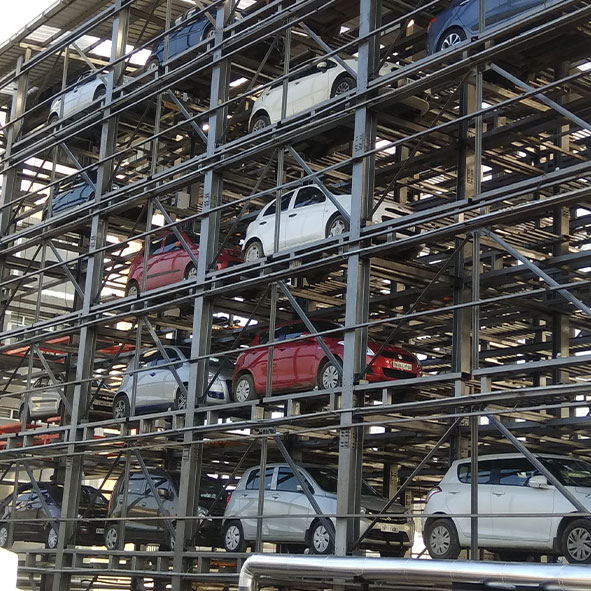Stacker Parking System
Stacker Parking System
Blog Article
Stacker Parking System
In the modern era of urbanization, efficient parking solutions have become a necessity. Among the innovative systems developed to tackle parking challenges, the stacker parking system stands out as a practical, space-saving, and cost-effective solution. This article delves deep into the workings, benefits, types, and applications of stacker parking systems, providing you with all the necessary insights to understand this revolutionary parking innovation.

What is a Stacker Parking System?
A stacker parking system is a mechanical parking solution designed to optimize parking spaces by utilizing vertical and horizontal arrangements. It operates on the principle of lifting and stacking vehicles one above the other, allowing multiple vehicles to occupy the space traditionally meant for one.
These systems are widely adopted in urban areas where space is a premium and conventional parking methods are no longer viable. Stacker parking systems can be customized to fit various needs, making them suitable for both residential and commercial use.
How Does a Stacker Parking System Work?
The functionality of a stacker parking system is straightforward yet highly efficient. Here are the key operational steps:
- Vehicle Placement: The driver parks the car on a designated platform.
- Lifting Mechanism: Using hydraulic or electric systems, the platform is lifted, creating space below for another vehicle.
- Access Control: Advanced systems include automated controls to retrieve the desired vehicle without manual intervention.
- Safety Measures: Sensors, locking mechanisms, and alarms ensure the safe handling of vehicles.
These systems are typically operated through user-friendly interfaces, such as remote controls, keypads, or mobile applications, ensuring a seamless experience.
Types of Stacker Parking Systems
1. Two-Post Stacker Parking Systems
This system features two vertical posts that support the lifting mechanism. It is ideal for residential garages and small-scale commercial use due to its compact design and affordability.
2. Four-Post Stacker Parking Systems
With increased stability and load capacity, four-post systems are better suited for commercial applications. They can accommodate heavier vehicles and are often used in car dealerships and service centers.
3. Puzzle Parking Systems
A more advanced variant, puzzle parking systems allow horizontal and vertical movement of platforms. This flexibility maximizes the utilization of limited space, making it ideal for urban parking lots.
4. Fully Automated Stacker Systems
Incorporating cutting-edge technology, these systems automate the entire parking process. They are designed for large-scale applications, such as airports, malls, and corporate buildings, where efficiency and speed are paramount.
Advantages of Stacker Parking Systems
1. Space Optimization
One of the most significant benefits of stacker parking systems is their ability to multiply parking capacity without expanding the footprint. This makes them an excellent choice for urban areas with limited land availability.
2. Cost-Effectiveness
Compared to constructing multi-level parking garages, stacker parking systems are more affordable. They require less material, labor, and time to install, making them a cost-efficient solution.
3. Enhanced Safety
Modern stacker systems are equipped with safety features such as sensors, alarms, and emergency stops. These ensure both vehicle and operator safety during operations.
4. Environmental Benefits
By reducing the need for sprawling parking lots, stacker parking systems help conserve land and reduce urban sprawl. Additionally, their energy-efficient designs minimize carbon footprints.
5. Convenience
With automated controls and user-friendly interfaces, these systems offer unparalleled convenience. Retrieving or parking a vehicle takes minimal time and effort.
Applications of Stacker Parking Systems
1. Residential Complexes
Stacker parking systems are an excellent solution for residential areas with limited parking space. They can be installed in underground garages or open spaces, accommodating more vehicles without requiring additional land.
2. Commercial Establishments
Shopping malls, office buildings, and hotels often face parking challenges due to high foot traffic. Stacker systems provide an efficient way to cater to the parking needs of visitors and employees.
3. Public Parking Lots
Urban centers and metro stations benefit greatly from stacker parking systems. These installations help manage high vehicle volumes, reducing congestion and improving traffic flow.
4. Automotive Dealerships and Service Centers
Car dealerships and service centers require optimized parking solutions for their inventory. Stacker parking systems ensure maximum space utilization and easy access to vehicles.
Challenges and Considerations
While stacker parking systems offer numerous benefits, it is essential to consider a few challenges:
- Initial Investment: Although cost-effective in the long run, the upfront cost of installation can be significant.
- Maintenance: Regular maintenance is required to ensure the system's reliability and safety.
- Space Requirements: Adequate height clearance is necessary for installation, which may not be feasible in all locations.
- Operational Training: Users need to be trained to operate the system efficiently, especially in manual or semi-automated setups.
Future of Stacker Parking Systems
With advancements in technology, stacker parking systems are becoming more efficient and accessible. Innovations such as IoT integration, AI-powered automation, and sustainable materials are expected to drive their adoption further. As cities continue to grow, the demand for space-efficient parking solutions will undoubtedly increase, making stacker parking systems a cornerstone of urban planning.
Report this page